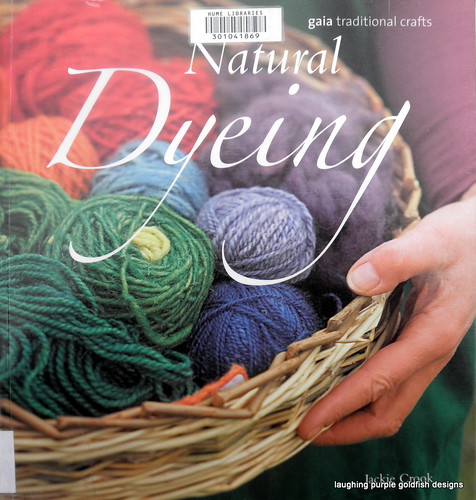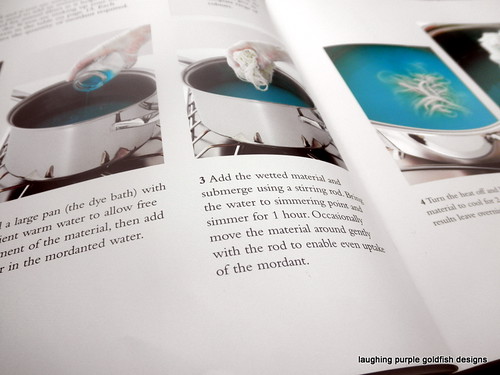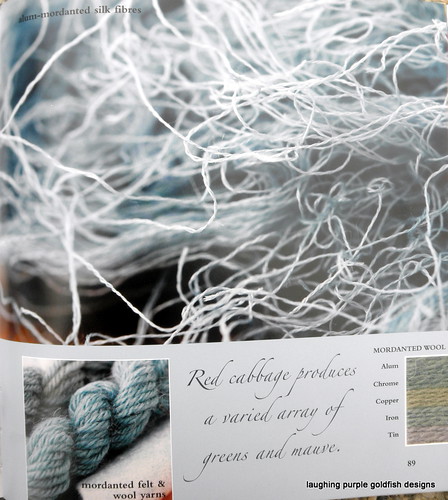
I've only dabbled a little bit with dyeing yarn.
Basically, I've worked using vinegar as a pre-mordant... food dye for the colouring... and the microwave method. It's fast, simple and effective - but it made me more curious about other methods of dyeing.
If you haven't experimented at home with your own microwave, then you might like to read about my experiences here. It really is very simple.
Unfortunately the microwave in the Goldfish Household died several months ago. For some reason or another (in fact - I haven't really worked out the details yet myself) I didn't want it replaced. Mr Goldfish has offered over and over again to replace it, but I've been quite determined to live without it.
There's only been two occasions on which I have REALLY missed it...
First was when the cold nights started to roll in recently, and I realised that I had no way of heating my MICROWAVE HEAT BAGS... you know, those nice ones filled with wheat and lavender oil... oh so toasty on a cold winter's night??? Bit tricky to use if you don't have a microwave!
(oh... and if YOU know of another way to heat one... you simply MUST leave a comment for me... pleeeease)
The second occasion was when it dawned on me that you CAN'T dye in the microwave if you DON'T HAVE a microwave. AArghhhhh!
Anyway
I'm sure that the point of this post was to talk about the book I've been reading this week:
Natural Dyeing by Jackie Crook
published by Gaia Traditional Crafts
Jackie has been experimenting with dyeing all sorts of materials over the last twenty years... and she shares her knowledge very clearly in this book. There are loads of photos on every page, showing clear step-by-step instuctions of preparation, mordanting, and the actual dyeing process.

The book also discusses about 30 different natural dyes in great detail, including photos of the resuting colours when different mordants are used.


Despite the clear instructions, and all that useful information... I've become aware of two huge problems for me with this type of dyeing.
Number One - I don't want to stuff around with hazardous chemicals. The dyes themselves may be 'natural'... but you need to use a mordant to help the colour to set. There are five discussed in the book... three of which are hazardous. As far as I'm concerned, if I can't safely pour it down my kitchen sink - then I don't want to be experimenting with it.
(mind you... I have no hesitation in melting vinyl records in my oven, or crocheting with video cassette tape - go figure)
Number Two - Jackie grows her own ingredients, and after reading through the pages in the book, I can understand why. Most of them I have never even heard of. Nor are they readily available here. There are some everyday dyes, like onion and cabbage and turmeric... but most of the were rather obscure.
So
Interesting as it was to read about, I won't be experimenting any time soon.
Though I do have some plans to play around with eucalyptus leaves and solar dyeing... if only I could find a book on that!
11 comments:
Looks like an interesting book. Eco Colour by India Flint is another great one to check out. Onion skins and eucalyptus doesn't really need a mordant and earth palate dyes (not natural but not really much worse that food colouring) don't need heat plus you can still use the food colouring/vinegar method and steam them on the stove instead.
Mum used to heat wheat bags in the frypan, can't remember exactly what she did but is probably worth googling. :)
forgot to add the India flint book includes stuff on both eucalytpus and solar dyeing.
My grandma, God bless her soul, used to dye her homespun wool in onion skins and walnut shells. Not wooden ones, the green ones, that are removed from the walnuts just after the picking/harvesting.
Anyway, the onion skins give all kinds of reddish-brown nuances, walnut shells dark brown-black colour.
The other grandma, God bless her soul too, used to dye her crochet doilies in tea or coffee to look more "natural" instead plain white.
They are not around to ask for tips, but, I'll try with mom, maybe she remembers something useful about the process.
Hello, haven't been around for a while.
I read an equally eye-catching book, and was daunted by the same problems - dangerous chemicals, difficult to access supplies and even the number of extra pans and pots I'd need.
I did have a link to some natural dye tips - I'll have to see if I can find it.
I can recommend coffee - spilt some on a white top, and it wouldn't budge through three washes , even with stain remover rubbed in. Only came out with a 4 hour soak in oxi-clean. ;-)
If you have a double boiler that can be heated without water in it (stainless steel will work), you can heat your microwave bag in the top part of it without scorching it.
I use an old crock pot for dyeing yarn. I actually like it better than the microwave; more consistent heat. They are easy enough to find second-hand so you can have one just for dyeing.
Regarding your wheat bags, you CAN heat them in your conventional
oven, google it perhaps, but obviously on a low heat. Kinda Victorian
in a way!
Keep up the great posts, Julie
vjestica... if your mum remembers anything useful, I'd love to hear about it
mary... thanks for that information on the india flint book... sounds like it would be well worth a read...
good idea to google the heat bag/frypan deal too... can't believe I didn't think of that myself!!!
sam, sam, sam, sam, sam.... HELLOOOOOOOOOOOOO....
nice to see you back again!
innerbanks... hmmm.... don't actually have a double boiler here, but I can see that it would do the job
and I love the crock pot idea for dyeing... will be keeping an eye out for one at the op shops
julie - thanks... off to visit google right now ... much appreciated!
Post a Comment